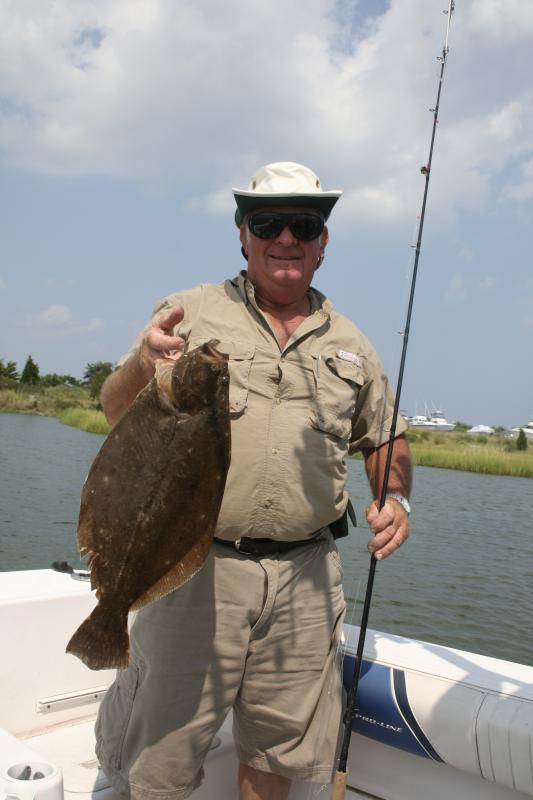
Indian River Bay is certainly one of the most popular spots for flounder during the spring, summer and fall. I began fishing there as a wee lad with my family in the early 1950s. Then in the 1960s and through the 1980s, we had a camper trailer at Bayshore Campgrounds in Ocean View, and I fished Indian River Bay from there.
For the purpose of this discussion, we will define Indian River Bay as beginning from a line joining the entrance to South Shore Marina to the entrance to Indian River Marina. We will treat Indian River Inlet as a separate piece of water.
If you launch your boat at Indian River Marina, you can begin fishing as soon as you clear the marina entrance. If the current is running in, you can drift up along the edge of Burton’s Island in the slough that runs there until you reach the sand bar at the western edge. On incoming water, you can run up the slough and drift back down. Make several drifts beginning close to Burton’s Island and working across the slough toward the sand bar on the south end. Make the last drift along the edge of that sand bar.
If it is high tide or close to high tide, head for the flat between the main channel, South Shore Marina, White’s Creek and the Junction Buoy at Massey’s Ditch. I fish an unweighted minnow on one line and a D.O.A. Shrimp or quarter-ounce leadhead with a Gulp! orange crawfish on the other.
I mentioned live minnows, Gulp! and D.O.A. shrimp as favored baits, but shad darts tipped with grass shrimp, strips of squid, live spot, one-quarter- to three-quarter-ounce bucktails and strips of fresh bait such as bluefish or menhaden will also attract flounder.
Try to make as little noise as possible in this shallow water. I shut off my outboard and only use my electric trolling motor. My boat is aluminum, so I try to move about as little as possible.
This flat only fishes well early or late in the day before the boat traffic picks up. Once people begin running across here towing water skiers and wake boarders, you can pretty much forget about flounder fishing.
Since you can’t control the tides and current, and have to fish when you have the time, you need to learn where the flounder are likely to be on the outgoing water as well as the incoming. This is where the channels come into play.
The one channel I never fish is the main one that runs from the inlet up to Millsboro. This is like Route 1 on a Saturday afternoon, one boat after another. Add to the congestion a couple dozen pontoon boats, a few tiny aluminum boats and a kayak or two drifting aimlessly along, and you have a recipe for disaster.
Since our camper trailer was at Bayshore, I spent a lot of time fishing the channel that runs alongside South Shore Marina. At one time, there was an old duck blind just west of the channel where the current had cut out a deep hole. That was one of my favorite spots and where I caught my largest flounder, an eight-pounder, on an unweighted minnow.
There is a drain from the marsh that flows into this channel and that is a hot spot on a falling tide. Otherwise, fish the edges as you would any other channel.
Moving up the bay toward Oak Orchard, the bottom flattens out with some holes and channels, and some shoreline that borders along a marsh. The marsh shorelines have gotten scarce in recent years as development moves up the bay. There are also creeks that empty into the bay.
All of this structure is worthy of exploration during the different stages of tide and current. While boat traffic is not quite as heavy up here as it is closer to the inlet, I still recommend an early start to the fishing day when you have less competition.
One of the biggest problems that comes with fishing the Indian River Bay is finding a flounder over 16.5 inches. I wish I had a remedy for this, but I don’t. I have thought about only fishing with live spot, but that would mean spending most, if not all, of the day without catching anything.
The largest flounder usually show up in the spring. They come into the bays because the water there is the first to warm and there will be lots to eat including grass shrimp, minnows and crabs. Once the water in the bays gets above 68 degrees, the big flounder head to the ocean. Another product of climate change.
The Link Lonk
February 06, 2021 at 05:22PM
https://ift.tt/3cPLeca
How to fish for flounder in the Indian River Bay - CapeGazette.com
https://ift.tt/35JkYuc
Fish
No comments:
Post a Comment